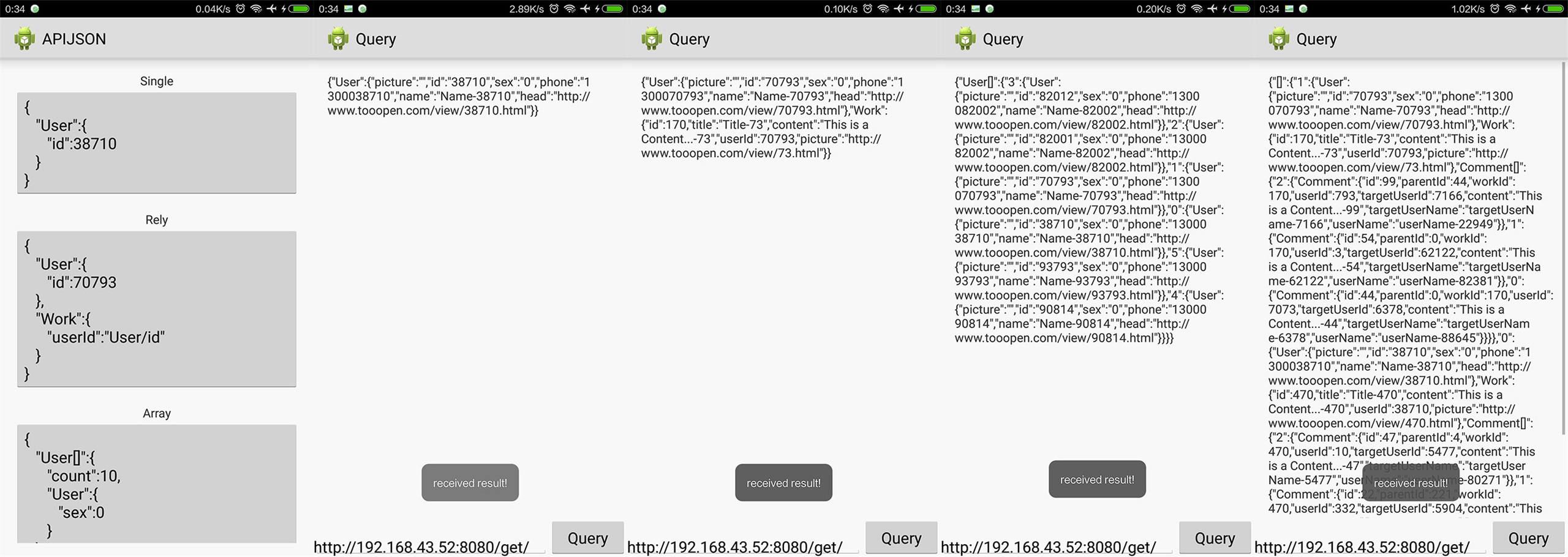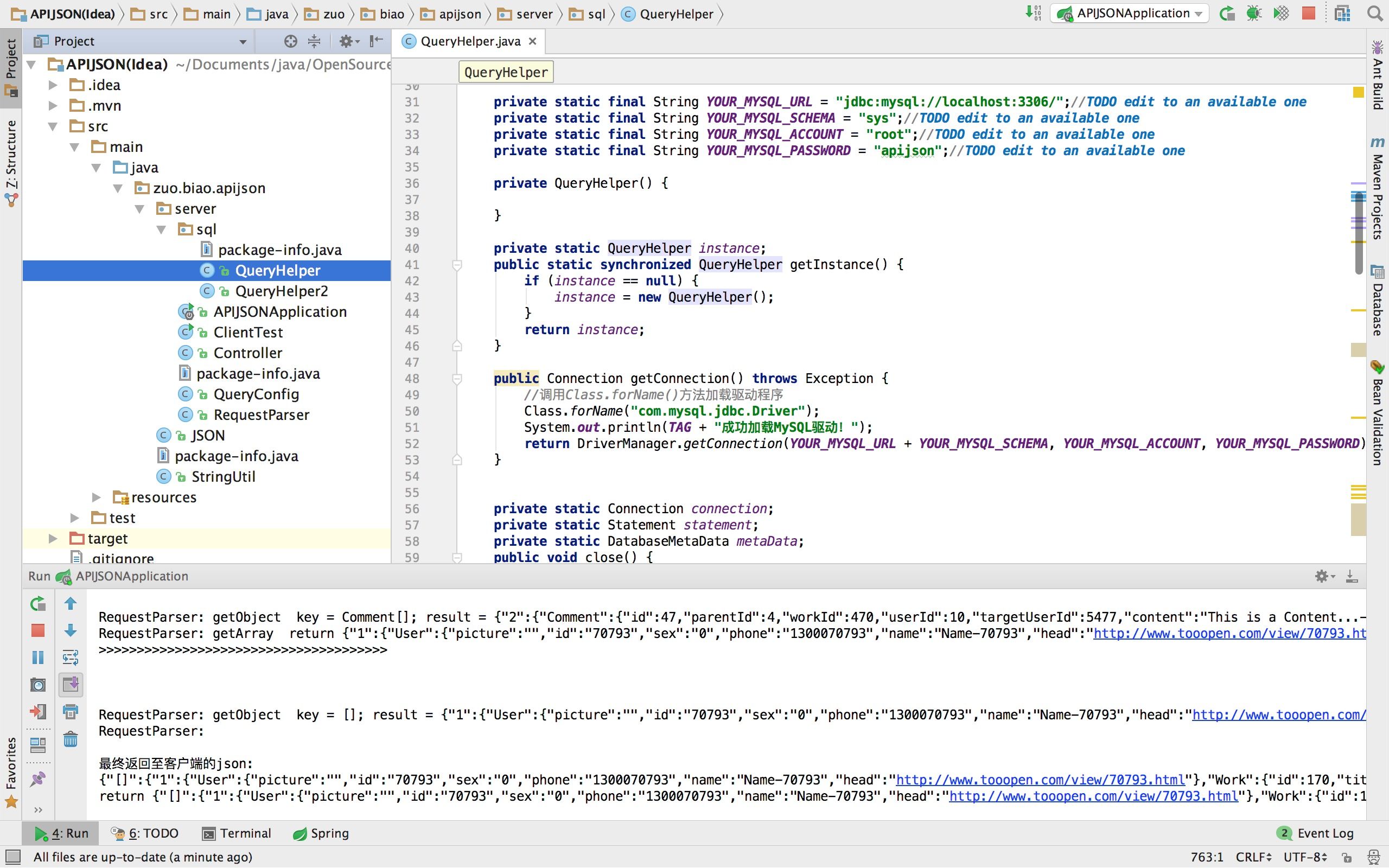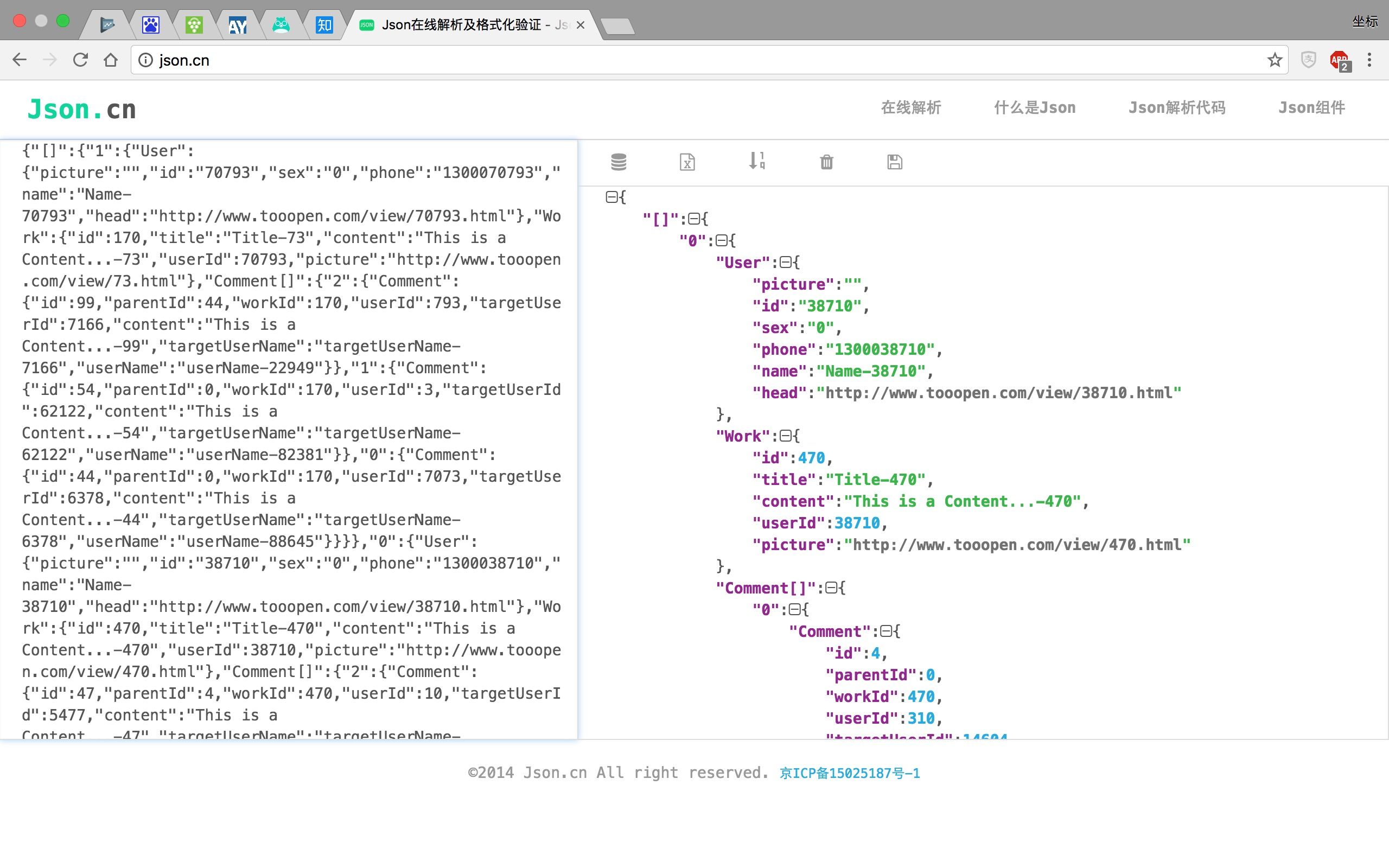APIJSON,讓接口見鬼去吧!
https://github.com/TommyLemon/APIJSON
什麼鬼?
APIJSON是啥?
APIJSON是一種JSON傳輸結構協議。
客戶端可以定義任何JSON結構去向服務端發起請求,服務端就會返回對應結構的JSON字符串,所求即所得。
一次請求任意結構任意數據,方便靈活,不需要專門接口或多次請求。
還能去除重復數據,節省流量提高速度!
從此HTTP傳輸JSON數據沒有接口,更不需要文檔!
客戶端再也不用和服務端溝通接口或文檔問題了!再也不會被文檔各種錯誤坑了!
服務端再也不用為了兼容舊版客戶端寫新版接口和文檔了!再也不會被客戶端隨時隨地沒完沒了地煩了!
這個APIJSON有這麼好?怎麼做到的?
舉個栗子:
請求:
{
"[]": { //請求一個array
"page": 1, //array條件
"count": 2,
"User": { //請求查詢名為User的table,返回名為User的JSONObject
"sex": 0 //object條件
},
"Work": {
"userId": “/User/id” //缺省依賴路徑,從同級object的路徑開始
},
"Comment[]": { //請求一個名為Comment的array
"page": 0,
"count": 3,
"Comment": {
"workId": “[]/Work/id” //完整依賴路徑
}
}
}
}
返回:
{
"[]":{
"0":{
"User":{
"picture":"",
"id":"38710",
"sex":"0",
"phone":"1300038710",
"name":"Name-38710",
"head":"http://static.oschina.net/uploads/user/1218/2437072_100.jpg?t=1461076033000"
},
"Work":{
"id":470,
"title":"Title-470",
"content":"This is a Content...-470",
"userId":38710,
"picture":"http://static.oschina.net/uploads/user/585/1170143_50.jpg?t=1390226446000"
},
"Comment[]":{
"0":{
"Comment":{
"id":4,
"parentId":0,
"workId":470,
"userId":310,
"targetUserId":14604,
"content":"This is a Content...-4",
"targetUserName":"targetUserName-14604",
"userName":"userName-93781"
}
},
"1":{
"Comment":{
"id":22,
"parentId":221,
"workId":470,
"userId":332,
"targetUserId":5904,
"content":"This is a Content...-22",
"targetUserName":"targetUserName-5904",
"userName":"userName-11679"
}
},
"2":{
"Comment":{
"id":47,
"parentId":4,
"workId":470,
"userId":10,
"targetUserId":5477,
"content":"This is a Content...-47",
"targetUserName":"targetUserName-5477",
"userName":"userName-80271"
}
}
}
},
"1":{
"User":{
"picture":"",
"id":"70793",
"sex":"0",
"phone":"1300070793",
"name":"Name-70793",
"head":"http://static.oschina.net/uploads/user/1174/2348263_50.png?t=1439773471000"
},
"Work":{
"id":170,
"title":"Title-73",
"content":"This is a Content...-73",
"userId":70793,
"picture":"http://my.oschina.net/img/portrait.gif?t=1451961935000"
},
"Comment[]":{
"0":{
"Comment":{
"id":44,
"parentId":0,
"workId":170,
"userId":7073,
"targetUserId":6378,
"content":"This is a Content...-44",
"targetUserName":"targetUserName-6378",
"userName":"userName-88645"
}
},
"1":{
"Comment":{
"id":54,
"parentId":0,
"workId":170,
"userId":3,
"targetUserId":62122,
"content":"This is a Content...-54",
"targetUserName":"targetUserName-62122",
"userName":"userName-82381"
}
},
"2":{
"Comment":{
"id":99,
"parentId":44,
"workId":170,
"userId":793,
"targetUserId":7166,
"content":"This is a Content...-99",
"targetUserName":"targetUserName-7166",
"userName":"userName-22949"
}
}
}
}
}
}



確實是一目了然,不用看文檔了啊!
我被文檔坑過很多次了都,文檔多寫或少寫了一個字段,字段寫錯或多個空格,或者字段類型寫錯,都不知道浪費了多少調試和溝通時間!
還有一次上頭糾結要不要把單層評論改成QQ微信那種多級評論,自己按照以前的接口寫了demo演示給上頭看,上頭很滿意決定實現需求,結果後端都沒和我商量自己改了接口返回的json結構,導致我這邊不得不重構解析代碼,真是醉了!
用APIJSON就可以自己按需定制返回的JSON結構,沒有接口,沒有文檔,就不會被文檔坑了,也不會有你說的後端拍腦袋定JSON結構導致的客戶端重構問題了哈哈!
Nice!
部分接口需要currentUserId和loginPassword的,你怎麼搞?
直接在最外層傳,例如:
{
"currentUserId":100,
"loginPassword":1234,
"User":{
"id":1
}
}
返回的狀態碼和提示信息放哪?
也是在最外層,例如對以上請求的返回結果:
{
"status":200,
"message":"success",
"User":{
"id":"1",
"sex":"0",
"phone":"1234567890",
"name":"Tommy",
"head":"http://static.oschina.net/uploads/user/1218/2437072_100.jpg?t=1461076033000"
}
}
一次請求任意結構任意數據,方便靈活,不需要專門接口或多次請求?
以前我做了一個界面,上半部分是用戶的信息,下半部分是他最近的動態,最多顯示3個,類似於微信的詳細資料。
我需要分別請求兩次:
User:
http://www.xxx.com/user?id=1
Moment列表:
http://www.xxx.com/moment/list?page=0&count=3&userId=1
現在是不是可以這樣:
User和Moment列表:
http://www.xxx.com/{"User":{"id":1}, "[]":{"page":0, "count":3, "Moment":{"userId":"User/id"}}}
對的,就是這樣。
好的。那重復數據怎麼去除呢?
比如QQ空間,裡面有一個動態列表,每條動態裡都有User和對應的動態內容Moment。
如果你進入一個人的空間,那就都是他的動態。
用傳統的方式返回的列表數據裡,每條動態裡都包含同樣的User,造成了數據重復:
請求:
http://www.xxx.com/moment/list?page=0&count=5&userId=100
返回:
{
"status":200,
"message":"success",
"data":[
{
"id":1,
"content":"xxx1",
...,
"User":{
"id":100,
"name":"Tommy",
...
}
},
{
"id":2,
"content":"xxx2",
...,
"User":{
"id":100,
"name":"Tommy",
...
}
},
...
]
}
有5條重復的User。
而使用APIJSON可以這樣省去4個重復User:
請求:
http://www.xxx.com/{"User":{"id":100}, "[]":{"page":0, "count":5, "Moment":{"userId":"User/id"}}}
返回:
{
"status": 200,
"message": "success",
"User": {
"id": 100,
"name": "Tommy",
...
},
"[]": {
"0": {
"Moment": {
"id": 1,
"content": "xxx1",
...
}
},
"1": {
"Moment": {
"id": 2,
"content": "xxx2",
...
}
},
...
}
}
如果之前已經獲取到這個User了,還可以這樣省去所有重復User:
請求:
http://www.xxx.com/{"[]":{"page":0, "count":5, "Moment":{"userId":100}}}
返回:
{
"status": 200,
"message": "success",
"[]": {
"0": {
"Moment": {
"id": 1,
"content": "xxx1",
...
}
},
"1": {
"Moment": {
"id": 2,
"content": "xxx2",
...
}
},
...
}
}
傳統方式也可以服務端在接口增加一個返回格式字段,根據這個字段來決定是否去除重復User啊
確實,不過這會導致以下問題:
1.服務端要新增字段和判斷字段來返回不同數據的代碼。
2.服務端要在文檔裡增加相關說明。
3.這個功能不一定用得上,因為客戶端的UI需求往往很容易變化,導致缺少使用這個功能的條件,為了一兩個版本去讓服務端和客戶端都折騰不值得。
而使用APIJSON就沒這些問題,因為根本不需要接口或文檔!而且是否去重只看客戶端的意願,服務端什麼都不用做。
這樣啊,贊!
哦對了,APIJSON相比傳統方式有沒有缺少的功能啊?
傳統方式能做的APIJSON都能做。
客戶端和服務端的http json交互:
客戶端 -封裝request -> 服務端 - 解析request - 生成response -> 客戶端
傳統方式request:
base_url/lowercase_table_name?key0=value0&key1=value1...
APIJSON request:
base_url/{TableName:{key0:value0, key1:value1 ...}}
TableName對應lowercase_table_name,key:value對應key=value,都是嚴格對應的,所以傳統方式request裡包含的信息APIJSON request一樣可以包含,傳統方式能實現的功能APIJSON肯定也都能實現。
好的
APIJSON怎麼保證服務端返回給不同版本客戶端的數據一致?
比如我上一個版本一個接口返回的值是a,現在這個版本要對所有版本客戶端返回a+b,用傳統方法只需要服務端把這個接口的返回值改下就好了,接口和客戶端都不用改。
用APIJSON不就會導致對有些版本返回的是a,有些是a+b,這樣就不能統一了?
APIJSON對請求的解析和響應的操作都是在服務端完成的,對應的是APIJSON(Server)裡的project。
服務端可以攔截到相關請求,比如請求a的值,把原本返回的a改成a+b就能保證對所有版本客戶端返回a+b。也不需要客戶端改代碼,至於接口就更不用管了,因為根本沒有接口。
那我要不一致呢?給不同版本客戶端返回不同的值。
首先這種需求是極少的,比如降低電影票的價格,你不能讓新版客戶端裡降價了,上個版本還是原價吧?
真有這種需求也可以通過客戶端在請求裡發送下版本號version,服務端根據版本號返回不同的值。
也是啊。那用APIJSON怎麼做權限處理?有些數據是要相關權限才能操作的。比如登錄賬號需要登錄權限,付款需要支付權限。
服務端獲取到客戶端的請求request後,在操作對應的table前用一個權限驗證類去驗證是否有操作權限,通過後才允許操作,否則返回錯誤信息。
權限驗證類可以是這樣的:
package zuo.biao.apijson.server.sql;
import java.rmi.AccessException;
import com.alibaba.fastjson.JSONObject;
import zuo.biao.apijson.StringUtil;
/**權限驗證類
* @author Lemon
*/
public class AccessVerifyer {
private static final String TAG = "AccessVerifyer: ";
private static final int ACCESS_LOGIN = 1;
private static final int ACCESS_PAY = 2;
public static final String KEY_CURRENT_USER_ID = "currentUserId";
public static final String KEY_LOGIN_PASSWORD = "loginPassword";
public static final String KEY_PAY_PASSWORD = "payPassword";
public static final String[] LOGIN_ACCESS_TABLE_NAMES = {"Work", "Comment"};
public static final String[] PAY_ACCESS_TABLE_NAMES = {"Wallet"};
/**驗證權限是否通過
* @param request
* @param tableName
* @return
*/
public static boolean verify(JSONObject request, String tableName) throws AccessException {
try {
verify(request, getAccessId(tableName));
} catch (AccessException e) {
throw new AccessException(TAG + "verify tableName = " + tableName + ", error = " + e.getMessage());
}
return true;
}
/**驗證權限是否通過
* @param request
* @param accessId 可以直接在代碼裡寫ACCESS_LOGIN等,或者建一個Access表,包括id和需要改權限的table的tableName列表
* @return
* @throws AccessException
*/
public static boolean verify(JSONObject request, int accessId) throws AccessException {
if (accessId < 0 || request == null) {
return true;
}
long currentUserId = request.getLongValue(KEY_CURRENT_USER_ID);
if (currentUserId <= 0) {
throw new AccessException(TAG + "verify accessId = " + accessId
+ " >> currentUserId <= 0, currentUserId = " + currentUserId);
}
String password;
switch (accessId) {
case ACCESS_LOGIN:
password = StringUtil.getString(request.getString(KEY_LOGIN_PASSWORD));
if (password.equals(StringUtil.getString(getLoginPassword(currentUserId))) == false) {
throw new AccessException(TAG + "verify accessId = " + accessId
+ " >> currentUserId or loginPassword error"
+ " currentUserId = " + currentUserId + ", loginPassword = " + password);
}
case ACCESS_PAY:
password = StringUtil.getString(request.getString(KEY_PAY_PASSWORD));
if (password.equals(StringUtil.getString(getPayPassword(currentUserId))) == false) {
throw new AccessException(TAG + "verify accessId = " + accessId
+ " >> currentUserId or payPassword error"
+ " currentUserId = " + currentUserId + ", payPassword = " + password);
}
default:
return true;
}
}
/**獲取權限id
* @param tableName
* @return
*/
public static int getAccessId(String tableName) {
if (StringUtil.isNotEmpty(tableName, true) == false) {
return -1;
}
for (int i = 0; i < LOGIN_ACCESS_TABLE_NAMES.length; i++) {
if (tableName.equals(LOGIN_ACCESS_TABLE_NAMES[i])) {
return ACCESS_LOGIN;
}
}
for (int i = 0; i < PAY_ACCESS_TABLE_NAMES.length; i++) {
if (tableName.equals(PAY_ACCESS_TABLE_NAMES[i])) {
return ACCESS_PAY;
}
}
return -1;
}
/**獲取登錄密碼
* @param userId
* @return
*/
public static String getLoginPassword(long userId) {
// TODO 查詢並返回對應userId的登錄密碼
return "123456";//僅測試用
}
/**獲取支付密碼
* @param userId
* @return
*/
public static String getPayPassword(long currentUserId) {
// TODO 查詢並返回對應userId的支付密碼
return "123456";//僅測試用
}
}
嗯,的確可行。剛看了項目主頁的介紹,感覺APIJSON確實非常強大方便,連接口和文檔都不用寫了,也不會在健身或者陪女朋友看電影時突然接到客戶端的電話了。
不過我還有一個問題,APIJSON是動態拼接SQL的,確實是靈活,但會不會導致SQL注入問題?
APIJSON拼接SQL是在服務端完成的,客戶端是不能直接發送SQL給服務端的。整個數據庫操作都是服務端完全可控的,服務端可攔截危險注入,風險不比傳統方式高。
厲害了我的哥!我去下載試試哈哈!
哈哈,我也要試試,請問怎麼獲取源碼?免費的嗎?
已在Github開源,完全免費。
https://github.com/TommyLemon/APIJSON
很棒!已Star!
Star +1,順便還Fork了一份研究嘿嘿!另外文檔很詳細贊一個!
有什麼問題或建議可以提issue或者發我郵件 [email protected],大家一起交流探討哈!
感覺我以後不用寫一大堆接口了,不需要寫兼容代碼了,也不需要寫文檔了。可以專注於數據的處理、監控、統計、分析了哈哈!
我也不用等服務端寫好接口才能請求了,現在自己定制返回的JSON,看請求就知道返回的JSON結構,可以直接寫解析代碼了哈哈!
(注:以上是對真實對話的改編)
APIJSON,讓接口見鬼去吧!
Github源碼及文檔:(歡迎Star,歡迎Fork)
https://github.com/TommyLemon/APIJSON